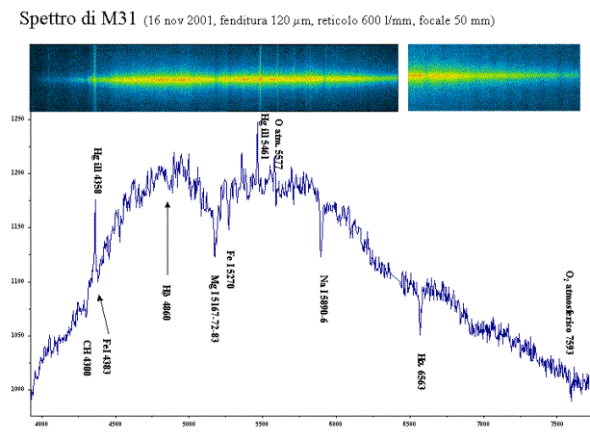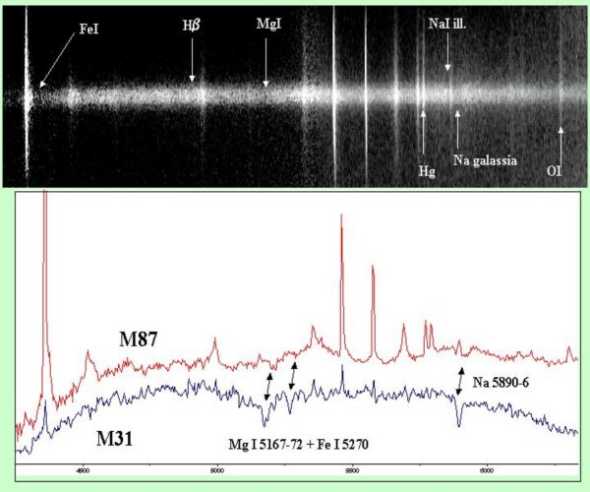EXTRAGALACTIC OBJECTS SPECTRA
Galaxies
- Seyfert
- Quasars
Spectrum of normal galaxies
It is rather difficult to find on the internet or in books the spectra of normal galaxies,
so when you spot for the first time a galaxy on the slit of your spectrometer you always
wonder which features you will see.
In my opinion, the spectrum of galaxies is among the more difficult to record both
because they are diffuse objects and with a spectrum that looks like a continuum,
spreading the feeble light entering the slit on all the wavelengths.
One can suppose that the spectrum of the light from a galaxy is the sum of the spectra
of all its stars.
But which will be the main contributions? The few but luminous hot stars or the
many small ones? From the few galactic spectra that I’ve obtained up to now it seems
that the main contribution comes from stars from the mid sequency (G and K), at least in
the central region. We can infact observe the lines of Fe I, Mg I, Na I, the Balmer
series and also the CH band but the molecular bands of cold stars or the He lines of
hot ones are not visible. Moreover, it shoud be considered that lines are Doppler
broadened due to the rotation of the galaxy (in the order of 200 Km/sec).

|
Picture 1: Spectrum of the central part of M31 (slit height is about 2’)
with 10 min exposure. Resolution is 5 Ĺ.
Spectrum is not corrected for atmospheric absorbtion and instrumental transmission
and CCD responsivity.
The main bands are due to Fe I, Mg I, Na I and H. Emission lines are mainly due to Hg
contained in the street lamps and to neutral oxigen in the terrestrial atmosphere
(5577.35, 6300.23 and 6363.88 Ĺ ). These lines can be used for wavelength calibration.
|
Identification of the lines in a spectrum of a galaxy is the first step forward the
measure of the red shift.
M31 is too close to be able to appreciate its red shift with our instrument.
If we take the Hubble constant equal to 60 Km/sec/Mpc, we find that M31 should run away
from us at a speed of only 40 Km/sec that is equivalent to a red shift of 0,7 Ĺ.
In reality the lines in the M31 spectrum show a small blue shift, due to the rotation
of the sun around our galaxy that produces an apparent motion directed at a point
called “solar apex” not far from Vega at R.A. 18h and DEC +30°.
Things work in a different way for M87 because at a distance of 60 millions of light
years the cosmological red shift is the most important contribution.
I have chosen M87 because of its luminosity despite its distance. Infact M87 is a giant
elliptical galaxy.
Picture 2 shows the red-shift of the absorption lines due to Fe, Mg, H and Na compared
to the street lamp lines and telluric oxygen emission lines used for calibration. The
average of the red-shift values Dl/l =0.0048 gives
a speed of V=CxDl/l
= 1450 Km/sec.
The correction for the motion of the sun toward the solar apex is +57.5 Km/sec
(angular distance apex-M87 is 77° thus Vcorr=cos (77°) x 250 Km/sec).
If we use the Hubble formula, assuming H=75 Km/sec/Mpc (half way the uncertainty
interval 50-100 Km/sec/Mpc) we obtain a distance of 20 Mpc or 65 million light years.

|
Picture 2. Up: the spectrum of M87 (sum of 3 exposures with CCD and grating 900 l/mm
of 5 minutes each) as it appears on CCD.
Prominent emission lines are due to Oxygen glow in the upper atmosphere and to mercury
and sodium contained in street lamps.
Down: A comparison between the spectra of M87 and M31 that shows the red-shift of lines
of Mg, Fe and Na.
|
Goto other extragalactic objects spectra:
Seyfert
- Quasars
|
|


